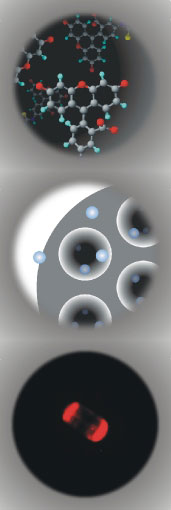Nanostructured Polymeric Materials
Synthesis of Microporous and Mesoporous Molecular Sieves
Commercial molecular sieves usually do not meet our requirements in terms of purity, morphology, and uniformity. We are therefore constantly involved in optimizing the synthesis of zeolites and mesoporous silicas, often for a specific application. Our main interest in the microporous range (below 2 nm) concerns the LTL framework. In the mesoporous range, we are primarily working with MCM-41 and SBA-15 type materials featuring adjustable pore sizes between 3 and 15 nm.
Positioning of Functional Groups
Mesoporous silicas generally feature total surface areas around 1000 m²/g. Functional groups on the external surface define the interaction of the particles with the surrounding medium, whereas groups on the internal surface can act as gates, sensors, or catalytic centers. We are designing methods to selectively modify external and internal surfaces, while maintaining control of the relative positioning of the functional groups. Tuning of the environment around specific grafting sites by means of nanopockets is an additional objective. An important part of this work involves the development of new techniques for the analysis of the functional group distribution.
Supramolecular Organization
Due to their robustness, optical transparency, and well-defined channel structures, zeolites and mesoporous silicas are ideal host materials for supramolecular organization. The inclusion of dye molecules into the parallel channels of zeolite L and arrays of silica nanochannels (ASNCs) yields materials which are able to efficiently transfer electronic excitation energy. Based on this concept we are developing new high performance pigments and photonic devices.
